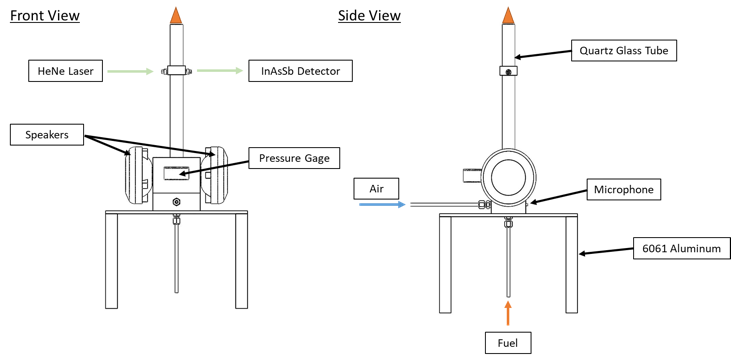 Manufacturers of power generating gas turbines are continuously pushing towards high-efficiencies and low-emissions. Lean premixed combustion is a promising control method of emissions. However, a frequent problem with these combustors is the onset of combustion instabilities which are a coupling between the dynamic heat release and the engines natural acoustic response. As manufacturers continue to push towards higher efficiencies, combustion instabilities become more rampant causing deterioration of critical engine components leading to costly maintenance and down time. Oscillations in the equivalence ratio, which is a measure of air to fuel ratios in the flow, have proven to be a large factor in the development of instabilities. Since there is currently very little information available for predicting instabilities, expensive trial and error procedures are a common suppression method for this phenomenon.
Manufacturers of power generating gas turbines are continuously pushing towards high-efficiencies and low-emissions. Lean premixed combustion is a promising control method of emissions. However, a frequent problem with these combustors is the onset of combustion instabilities which are a coupling between the dynamic heat release and the engines natural acoustic response. As manufacturers continue to push towards higher efficiencies, combustion instabilities become more rampant causing deterioration of critical engine components leading to costly maintenance and down time. Oscillations in the equivalence ratio, which is a measure of air to fuel ratios in the flow, have proven to be a large factor in the development of instabilities. Since there is currently very little information available for predicting instabilities, expensive trial and error procedures are a common suppression method for this phenomenon.  The purpose of this research is to advance the currently unavailable information on the prediction of instabilities by observing equivalence ratio oscillations on the swirl-plane of a lean premixed swirl combustor and its impact on combustion instabilities. The equivalence ratio is measured with a Helium-Neon laser probe obtaining the absorption spectra of hydrocarbons at 3.39. A swirl combustor has been designed to observe these phenomena while altering total flow rates, driving acoustic waves in the flow, and varying geometry of the combustor. The lab utilizes this test rig along with others to further the information available on combustion instabilities in combustors.
The purpose of this research is to advance the currently unavailable information on the prediction of instabilities by observing equivalence ratio oscillations on the swirl-plane of a lean premixed swirl combustor and its impact on combustion instabilities. The equivalence ratio is measured with a Helium-Neon laser probe obtaining the absorption spectra of hydrocarbons at 3.39. A swirl combustor has been designed to observe these phenomena while altering total flow rates, driving acoustic waves in the flow, and varying geometry of the combustor. The lab utilizes this test rig along with others to further the information available on combustion instabilities in combustors.
